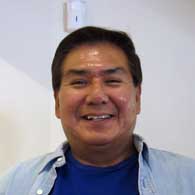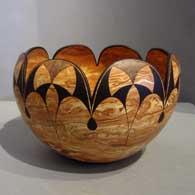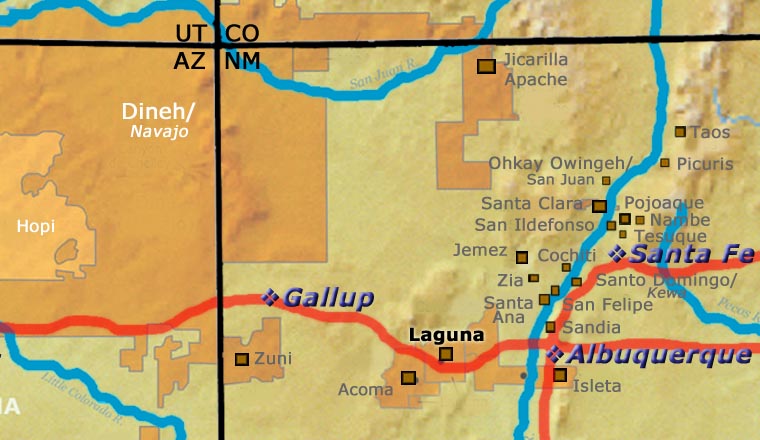
Calvin Analla Jr.
Laguna

Born in 1958, Calvin Analla Jr. is a traditional Laguna Pueblo potter from the village of Paguate, eight miles north of Old Laguna. His father, Calvin Analla Sr., is from Laguna, his mother, Velma Analla, is Navajo. Calvin began creating his style of potting in 1990 after observing his paternal grandmother, Evelyn Cheromiah and his aunt, Lee Ann Cheromiah, and experimenting with their methods, styles and designs.
In addition to Evelyn and Lee Ann Cheromiah, Calvin is related to two other famous potters: his sister Yvonne Analla Lucas and her husband, Hopi potter Steve Lucas. One day in his workshop Calvin was a bit short of clay and he asked Steve if he could spare a handful. Calvin's mixing of Hopi clay and his Laguna clay led to what is now Calvin's signature look. His pottery is also distinguished by very thin walls, scalloped rims and fine painted lines with details of sky elements and ancient designs.
Calvin has been making his pots for more than 20 years, participating in shows at the Heard Museum in Phoenix, the Santa Fe Indian Market, the Autry National Center in Los Angeles, The Eiteljorg Musum of American Indians and Western Art in Indianapolis, and the Gallup Intertribal Indian Ceremonial along the way. He's earned a collection of Judge's Choice and First and Second Place ribbons over the years. Calvin sees his journey as contributing to a new expression for historic Laguna designs through his experiments with techniques and pottery processes.
Calvin says his favorite shapes to make are canteens and storage jars. He also prefers working with marbleized clay and decorating his creations with pre-contact Laguna designs.
100 West San Francisco Street, Santa Fe, New Mexico 87501
(505) 986-1234 - www.andreafisherpottery.com - All Rights Reserved

Laguna Pueblo
After the Pueblo Revolt of 1680, the pueblos were fearful of Spanish reprisals. Spanish militias returned several times in the 1680s, looting and burning before returning to safety south of El Paso. In those years, when the Puebloans became aware of approaching Spanish forces they mostly scattered into the mountains and the Spanish found empty pueblos, easy to loot and easy to burn. When Don Diego de Vargas marched north in 1692, he was intent on reconquering Nuevo Mexico and re-establishing a long-term Spanish presence there. As the conquistadors who accompanied him were on a "do-or-die" mission, the reconquest took on a tenor quite different from the previous missions...
At first de Vargas followed a path of reconciliation with the pueblos but that was soon replaced with an iron fist that brought on a second revolt in 1696. The pueblos didn't fare so well the second time around and a large number of Pueblo warriors were executed while their wives and children were forced into slavery. When word of de Vargas actions got back to the King of Spain, he ordered de Vargas banned from the New World. However, most of the damage was already done.
Many modern historians say Laguna Pueblo was established between 1697 and 1699 by refugees seeking to avoid the fighting with the Spanish. Many of those refugees had left the first pueblos approached by the Spanish in 1692. Most had scattered to more remote places like Acoma, Zuni and Hopi, or to more Spanish-friendly Isleta. However, the pressure of those refugees strained the resources of the other pueblos and quickly forced the refugees to consider starting a new existence in a newly-formed pueblo.
In the 1000s CE, groups of Keres-speaking people were migrating out of the Chaco Canyon area. Some went to the south around the west side of Mount Taylor (and eventually to Acoma), and some went around the east side. Those who went around the east side of the ancient volcano came to a large lake where they decided to settle. The number of abandoned pueblos in the area says they stayed close to that lake for many years, moving only as drought and exhausted soils forced them to. That lake is what caused the Spanish to name the village "Laguna" several hundred years later. Some of the land under Laguna control has also been found to contain archaeological resources dating as far back as 3,000 BCE.
On the east side of today's Laguna Reservation is where the Puerco River of the East flows. There were numerous pueblos established along the Puerco between about 1250 and 1450 CE. Among them was a village now named Pottery Mound, named for the massive mounds of potsherds in and around the ruin. Pottery Mound was abandoned before the Spanish first arrived but archaeologists have followed the tracks left by Pottery Mound styles, shapes and designs to Acoma, Zuni and to settlements in the Hopi mesas and the Four Corners area.
In the 1700s, several villages were established in the area around Old Laguna and when the Lagunas were granted their own reservation, they were given about 500,000 acres of land, making Laguna one of the largest of all pueblos in terms of land. However, only about half the enrolled members of the tribe live at Laguna as many have been drawn to nearby Albuquerque in search of work.
Laguna and Acoma share the same language (Western Keres), similar pottery styles and similar religious beliefs. However, pottery making almost died out at Laguna after the railroads arrived in New Mexico in 1880 and laid a primary east-west trackbed directly in front of the Laguna main pueblo. During that time period many Lagunas went to work on railroad construction crews and many of the traditional Laguna arts and crafts died out. It didn't help when a Methodist missionary was elected pueblo governor in 1872. Among his first steps in office was an order to destroy all the kivas on Laguna land. That caused a schism in the tribe and, shortly, about half the Lagunas left their reservation and relocated to Isleta. Many of them returned to Laguna years later but there are still some at Isleta.
Pottery making never completely stopped at Laguna but by 1960 it was almost gone. Then in 1973 and again in 1974 Nancy Winslow (an Anglo woman from Albuquerque) taught two four-month arts and crafts classes at the pueblo. Among the 22 pueblo members in the first class were Evelyn Cheromiah and her daughters. Rick Dillingham quoted Evelyn Cheromiah as saying that after "looking at my mother's pottery-making tools, I got the urge of going back to making pottery." That was the beginning of today's renaissance in Laguna pottery.
Because of their geographic proximity, Laguna and Acoma clays are very similar, although Laguna clay tends to be a bit more sandy. In some instances, it's very hard to determine if a particular pot is from Acoma or from Laguna. Laguna potters are more likely to temper their white clay with sand than with ground potsherds like the Acomas do. Laguna geometric designs also tend to be bolder than Acoma designs while Laguna potters use Mimbres designs much more sparingly than do Acoma potters.
100 West San Francisco Street, Santa Fe, New Mexico 87501
(505) 986-1234 - www.andreafisherpottery.com - All Rights Reserved
